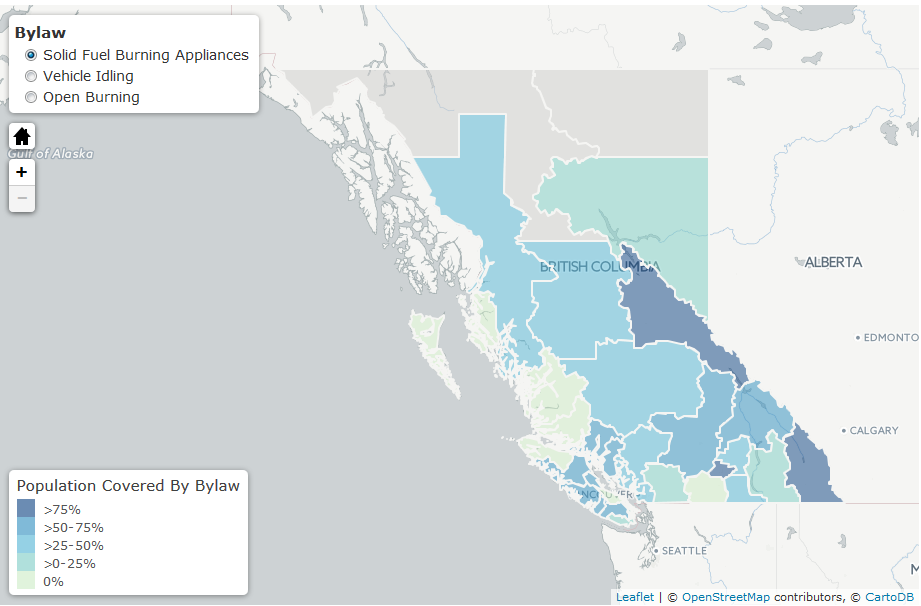Status of Air Quality Bylaws in B.C.
Poor air quality occurs when air pollutants reach high enough concentrations to endanger human health and the environment. Air pollution can stem from many different sources, such as motor vehicle exhaust, burning of solid fuels such as wood, and industrial air emissions. Air quality management tools—including financial rebates, airshed management plans, education and legislation—can assist jurisdictions in protecting or improving air quality. Local governments, for example, have the authority to pass bylaws to control emissions from some sources, such as vehicle idling, open burning and solid fuel (wood) burning appliances. This indicator reports on the occurrence and population coverage of air quality bylaws across regional districts in British Columbia.
- Air quality is linked to human health. Poor air quality has been linked to many adverse health effects such as breathing difficulties, exacerbation of allergies and aggravation of respiratory or cardiovascular conditions.
- Two primary air pollutants in B.C. include fine particulate matter and ground-level ozone. Major sources of fine particulate matter include vehicle emissions, open burning and solid fuel (wood) burning appliances. Vehicle emissions also include precursor pollutants that cause the formation of ground-level ozone. Local government air quality bylaws often focus on these three emission sources because thier management can significantly improve local air quality.
- Open burning and solid fuel burning appliance bylaws are both prevalent in B.C. Open burning bylaws are in place in 70 municipalities within 24 regional districts, and 52 municipalities within 22 regional districts have solid fuel burning appliance bylaws. These bylaws each cover 29% and 35% of the total B.C. population respectively.
- Vehicle idling bylaws in B.C. cover 35% of the B.C. population. Vehicle idling bylaws are in place in 30 municipalities within 15 regional districts. Idling bylaws tend to be in place in urban areas and densely populated municipalities where vehicle idling can become a significant source of local air pollution.
- Air quality challenges vary across regions in British Columbia. Vehicle emission concerns are more prevalent in urban areas, such as Metro Vancouver, whereas solid fuel (wood) burning appliances are more common in parts of B.C. where alternative heating options are inaccessible or more costly.
Did You Know?
If every driver in Canada reduced their idling time by 3 minutes a day, over one year we would save1:
• 630 million litres of fuel
• $630 million dollars in fuel costs
• 1.4 million tonnes of greenhouse gas emissions
The most common vehicle idling time limit found in B.C. municipal bylaws is 3 minutes.
Tip: Toggle over the map to view the population coverage of three air quality bylaws—vehicle idling, open burning and solid fuel (wood) burning appliances—across regional districts in British Columbia in 2016. Clicking on each regional district provides details on the status of air quality bylaws for all municipalities and unincorporated areas.
Methods
The air quality bylaw census data was collected in 2016. The three air quality bylaw inventories reported here are based on the following methodologies:
- Open burning bylaw: Open burning bylaws are included if motivated solely by air quality or by fire hazard protection and air quality combined through the application of the Open Burning Smoke Control Regulation.
- Vehicle idling bylaw: All anti-idling bylaws and street, traffic, noise control, nuisance, good neighbour and smoking and idling control bylaws were included if they contained the following provisions for improving air quality: idling restrictions must apply to all vehicle types, idling rules do not allow a vehicle to idle longer than 3 minutes and the bylaw applies to all areas of the municipality (residential and commercial).
- Solid fuel burning appliance bylaw: Solid fuel burning appliance bylaws are included if they are specific to wood burning appliances and any fire service bylaws or building bylaws that require wood burning appliances to have Canadian Standards Association or Environmental Protection Agency certification or significant air pollution prevention provisions.
Population coverage was calculated using 2015 B.C. population estimates by regional district sourced from BC Stats, the central statistical agency of the Province of British Columbia. Two areas in the northern region of the province are not located within Regional District boundaries (Stikine Region and Northern Rockies Regional Municipality) and consequently were not included in the analysis.
Regional districts and municipalities that wish to update the air quality bylaw data reported above should contact the Environmental Standards Branch through the B.C. Air Quality contact web form.
References and Other Useful Links
- Learn more about air quality in British Columbia
- View more B.C. air quality indicators
- British Columbia Environmental Management Act
- British Columbia Open Burning Smoke Control Regulation
- British Columbia Solid Fuel Burning Domestic Appliance Regulation
- Read past British Columbia Air Quality Bylaw Inventory reports
- 1Natural Resources Canada - Office of Energy Efficiency
Data
*By accessing these datasets, you agree to the licence associated with each file, as indicated in parentheses below.
Download a printable version of this indicator (PDF, 4.7MB)
Updated February 2017
Suggested Citation: Environmental Reporting BC. 2017. Status of Air Quality Bylaws in B.C. State of Environment Reporting, Ministry of Environment, British Columbia, Canada.


 Your screen is too small to display the interactive map. Click to see the interactive visualization in full-screen.
Your screen is too small to display the interactive map. Click to see the interactive visualization in full-screen.
